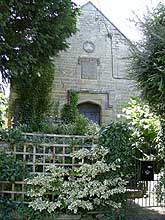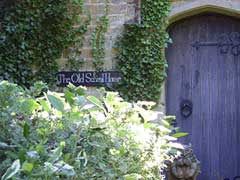Fifehead Magdalen School, Dorset, England
 Fifehead
Magdalen village school was founded in the building
opposite Church Farm in Fifehead Magdalen in the dwelling
now called Home Farm. Fifehead
Magdalen village school was founded in the building
opposite Church Farm in Fifehead Magdalen in the dwelling
now called Home Farm.
Home Farm was one of the old farmhouses of the Manor, occupied
by members of the Newman family in earlier periods, and later
by their tenants, but becoming linked with and subordinate
to Church Farm.
About 1780 the house was leased to a family named Hunt
and during their occupancy it was re-faced with dressed stone
and called THE VILLA. Mr and Mrs Hunt, and
later their daughter, carried on the school at their premises
but their two sons farmed extensively in West Stour.
In 1840 the school was being conducted by Miss Sarah
Hunt, assisted by a Miss Dowding
of the Fifehead Mill family.
 It
had 28 boarding pupils between the ages of 7 and 15, 9 boys
and 19 girls, and in the first four censuses of the century,
when individual names were not recorded, the Fifehead figures
are inflated by numbers of this order, quite a high percentage
when there were only sixty or so village children. It
had 28 boarding pupils between the ages of 7 and 15, 9 boys
and 19 girls, and in the first four censuses of the century,
when individual names were not recorded, the Fifehead figures
are inflated by numbers of this order, quite a high percentage
when there were only sixty or so village children.
This was the school where selected children were taught to
read and write in the period 1785~1804, with their fees being
paid by the parish. In addition to the boarding pupils, the
school also taught up to ten village children whose fees were
paid from the poor law rate income.
The pupils were taught to write and/or read, not always both,
and the fees were £1 a year for writing lessons and eleven
shillings a year for reading lessons. The building continued
to be used as a school until 1856 and then became the home
of persons whose names were included in the section of the
local directory which was reserved for the details of gentry.
In the directory's editions of the next fifty years Fifehead
had just three such entries - the names of the residents of
Fifehead House, The Villa and The Vicarage.
After 1856 the vicar developed the village school, building
it up from the Sunday school and "Lame School" which had subsequently
been carried on in the carpenter's shop premises. He provided
a new school and school house at his own expense and obtained
financial help with its maintenance from an ecclesiastical
charity.
When the Education Act of 1870 brought about the introduction
of state education, he formed a School Board to obtain government
grants for the school but it was never a church school and,
after School Boards were abolished in 1903, it became the
responsibility of the Dorset County Council which closed it
in 1911.
The school was built to hold sixty pupils but, as far as
can be ascertained, it never catered for more than half that
number and this was presumably the reason for its comparatively
early demise.
The schoolmistress moved from the school-house and The Villa,
too, experienced several changes of fortune, as if to conform
with its no longer being dignified with the directory's classification
as a home of gentry, before once again becoming a farmhouse
in the 1930s.
Our Great Great Grandmother Albetina Hunt attended
the village school in Fifehead Magdalen, Dorset
and appeared on the census there in 1851 aged 12.
At that time here were only 14 girls mainly 9 - 16, and 2
- 7 year old boys boarding at the school.
The staff seemed to be -
- Sara S. White, Head, 27, School Mistress,
born Hampreston? Dorset
- Mary White 23, Governess.
- Ellen White 32, Farmer's daughter.
- Elizabeth, Servant, House Servant
- Martha Bennett, Servant, House Servant.
In 1848 Fifehead Magdalen was described as follows:
FIFEHEAD-MAGDALENE (All Saints), a parish,
in the union of Sturminster, hundred of Redlane, Sturminster
division of Dorset, 6 miles (W. by S.) from Shaftesbury; containing
229 inhabitants. 
This place belonged to the celebrated abbey of St. Augustine,
Bristol, and in the 34th of Henry VIII. was, with the advowson
of the vicarage, granted to the bishops of Bristol, under
whom the manor was held for several generations by the family
of Newman.
The parish is situated on the river Stour, near the road
from Exeter, via Yeovil, to London, and comprises 956 acres
by measurement; the land is fertile, and principally pasture.
The living is an endowed vicarage, valued in the king's books
at £7, and in the gift of the Bishop of Gloucester and Bristol:
the tithes have been commuted for £245, and the glebe comprises
24 acres.
The church has been repaired; the walls have been raised,
the building new roofed, and a tower added.
From: 'Fetcham - Fincham', A Topographical Dictionary of
England (1848).
On the 1841 census the following were recorded at the school

- Sarah HUNT; f; 50; Conducting a School;
- Mary DOWDING; f; 35; Ind;
- Emma HUNT; f; 11; Pupil;
- Mary HUNT; f; 10; Pupil;
- James HUNT; m; 7; Pupil;
- Charles HAYTER; m; 11; Pupil;
- William HAYTER; m; 9; Pupil;
- Samuel HAYTER; m; 7; Pupil;
- Sarah COOMBS; f; 13; Pupil;
- Elizabeth DAVIS; f; 12; Pupil;
- Mary DAVIS; f; 10; Pupil;
- Amelia DAVIS; f; 7; Pupil;
- Susan DORE; f; 11; Pupil;
- Ann FRY; f; 12; Pupil;
- Francis FARNHAM; f; 15;
- Isabel JEFFERY; f; 15;
- Elizabeth LAPHAM; f; 14;
- Mary MILES; f; 13; Pupil;
- Frederick MILES; m; 11;
- Elizabeth MEATYARD; f; 8; Pupil;
- Joseph MITCHELL; m; 10; Pupil;
- Emma REBBECK; f; 10; Pupil;
- Martha SENIOR; f; 11; Pupil;
- James SNOOK; m; 9; Pupil;
- John SNOOK; m; 7; Pupil;
- George STACEY; m; 10; Pupil;
- Mary YOUNG; f; 10; Pupil;
- Susan YOUNG; f; 8; Pupil;
- Rebecca YOUNG; f; 6; Pupil;
- Elizabeth ROBERTS; f; 13; Pupil;
- Samuel ROBERTS; m; 11; Pupil;
- Elizabeth FIFETT; f; 20; F.S.;
|
